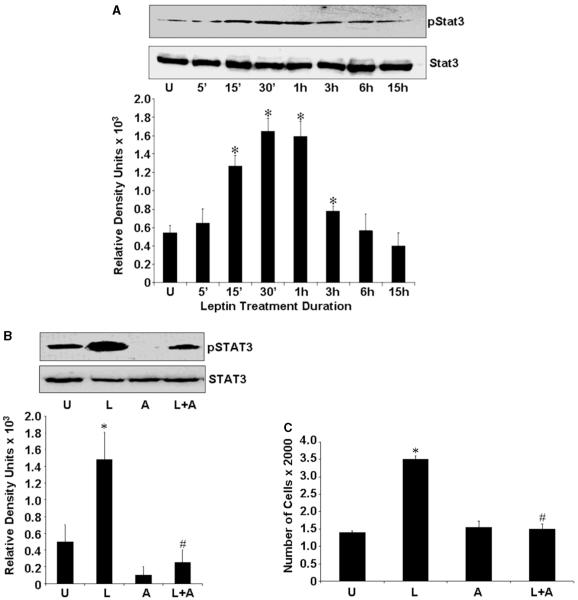Figure 2.
Leptin stimulates the phosphorylation of STAT3. (A) ECC1 were cultured, serum starved for 16 h and treated with leptin (100 ng/ml) for various intervals of time. Time zero represents the absence of leptin or untreated cells (‘U’). Cell lysates were prepared and quantified for protein content. A total of 100 μg protein were resolved on 10% SDS-PAGE, followed by immunoblot analysis with specific antibodies against total or phosphorylated (p) forms of STAT3. The representative histogram is the densitometric analysis of bands demonstrating fold increase in levels of pSTAT3 with respect to STAT3, at various intervals of leptin treatment. These data are representative of multiple independent experiments with a representative immunoblot for pSTAT3 and STAT3. The histogram represents densitometric mean values±s.e.m. of band intensities. *P < 0.05, compared with untreated (‘U’) control cells. (B) ECC1 cells were serum starved and stimulated with 100 ng/ml leptin (‘L’) or 100 μM AG490 (‘A’). For combined treatment, cells were pretreated with 100 μM AG490 for 45 min followed by leptin treatment (‘L + A’). Untreated controls are designated as ‘U’. Total proteins were immunoblotted with specific antibody against total or the phosphorylated form of STAT3. The representative histogram is the densitometric analysis of bands demonstrating fold increase in levels of pSTAT3 with respect to STAT3. *P < 0.01, compared with untreated (‘U’) control cells; #P < 0.05, compared with leptin (‘L’) treatment. (C) Leptin fails to induce proliferation of ECC1 cells in the absence of JAK/STAT3 phosphorylation. Cells were treated with leptin and AG490 as described earlier and XTT assays were performed as described in ‘Materials and methods’. The data represent experiments performed three times in triplicates. *P < 0.001, compared with untreated (‘U’) control cells; #P < 0.005, compared with leptin (‘L’) treatment.

